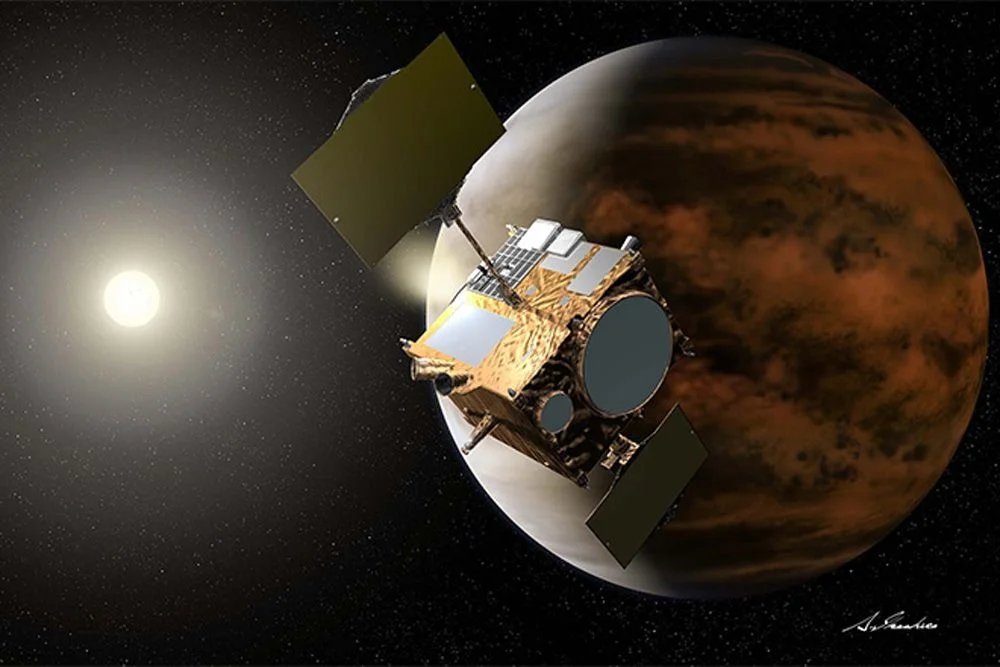uaetodaynews.com — Venus loses its last active spacecraft, as Japan declares Akatsuki orbiter dead
Humanity’s last active mission at Venus is no more.
The Japanese Aerospace Exploration Agency (JAXA) declared its Akatsuki spacecraft dead on Tuesday (Oct. 28), more than a year after the Venus climate probe failed to respond to calls from mission control.
JAXA noted that the Akatsuki mission produced 178 journal papers and counting, and that it tripled its 4.5-year design lifetime — even though the probe missed its first shot at orbiting Venus.
The $300 million spacecraft, also known as the Venus Climate Orbiter, launched in 2010 and experienced a failure of its main engine along the way, missing the chance for a crucial burn to enter orbit. Incredibly, however, the mission survived long enough for a second try at orbital insertion in 2015, when Akatsuki drew close to Venus after five years of orbiting the sun.
“With the main rocket engine damaged, the team were forced to get creative,” JAXA wrote in the statement. “The spacecraft would have to attempt capture using the less powerful thrusters that were designed for the tasks of attitude control and fine adjustments. Orbit insertion had never previously been achieved with such a method, but exploration has always been about redefining the impossible.”
Akatsuki not only made it but persisted in its exploration of Venus for nearly a decade. JAXA announced it had lost contact with the spacecraft on May 29, 2024 after about a month of communication issues.
Akatsuki aimed to learn more about the climate of Venus, which has surface temperatures hot enough to melt lead, alongside crushing pressure that has destroyed past landing missions in minutes. As an orbiter, Akatsuki focused on the cloud bank of Venus that is about 30 to 43 miles (50 to 70 kilometers) above the surface.
“In this region, winds whip at speeds that approach the Shinkansen bullet trains, 60 times faster than the planet rotation — a phenomenon that is known as ‘super rotation,’” JAXA wrote. While Venusian clouds whip around the planet in about four Earth days on average, Venus’ extremely slow rotation means a single Venusian day lasts the equivalent of 243 days on our planet.
Akatsuki made progress in learning about super rotation. “As Akatsuki gazed steadily at the Venusian surface, researchers mapped the clouds between hundreds of images, measuring their speed as they slid around the globe,” JAXA stated. “This analysis revealed that the acceleration of the clouds depended on the local solar time, suggesting that the incredible rotation speeds were being maintained by solar heating.”
The finding has implications for life beyond Earththe agency added. Venus orbits the sun in just 225 days, a shorter duration than its rotation. This means the planet is nearly tidally locked, which would be the case if its surface perpetually had one hemisphere facing the sun (just like Earth’s moonwhose near side constantly faces our planet.)
“Many of the extrasolar planets discovered may be in tidal lock, and there is an ongoing debate as to whether this impedes their chances of habitability,” JAXA wrote. “Without a mechanism to redistribute heat, air on the nightside of a tidally locked world would freeze and cause global atmospheric collapse. However, if Venus’s rapid atmosphere rotation is driven by thermal input from the star, then this could be a common mechanism that would redistribute the heat fast enough on tidally locked worlds to save their air.”
Akatsuki initially launched with six instruments, all of which were still working when it entered the orbit of Venus in 2015. Two infrared cameras stopped working about a year after orbital insertion, but the last four instruments were believed to still be healthy when Akatsuki stopped communicating in 2024.
The mission made some other discoveries as well, JAXA said. Scientists spotted a bow-like feature in the atmosphere that lasted for at least four Earth days, which researchers suggested was due to mountains on Venus allowing lower-atmosphere gas to move higher as a “gravity wave” to a greater extent than observed on Earth. But learning more will require new Venus missions, JAXA said.
And there are some in the planning stages. For example, NASA is working on a mission called DAVINCI, which is designed to penetrate the atmosphere, and another one called VERITAS, which will orbit the planet in search of information about its surface and interior. And the European Space Agency is developing EnVision, an orbiter that will study the atmosphere, interior and surface of Venus.
Both DAVINCI and VERITAS, however, are at threat of losing funding in President Donald Trump’s 2026 NASA budget request, which slashes agency funding by 24% and cancels dozens of science missions. What happens next is still being debated by politicians during the ongoing U.S. government shutdown that started on Oct. 1, when funding was not agreed to for the new fiscal year.
Disclaimer: This news article has been republished exactly as it appeared on its original source, without any modification.
We do not take any responsibility for its content, which remains solely the responsibility of the original publisher.
Disclaimer: This news article has been republished exactly as it appeared on its original source, without any modification.
We do not take any responsibility for its content, which remains solely the responsibility of the original publisher.
Author: uaetodaynews
Published on: 2025-10-30 03:27:00
Source: uaetodaynews.com
